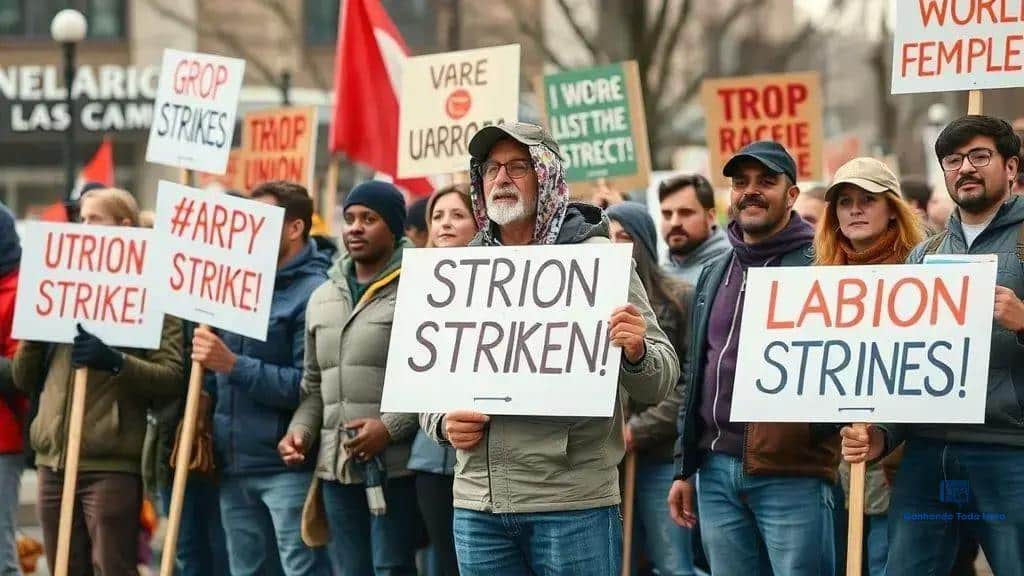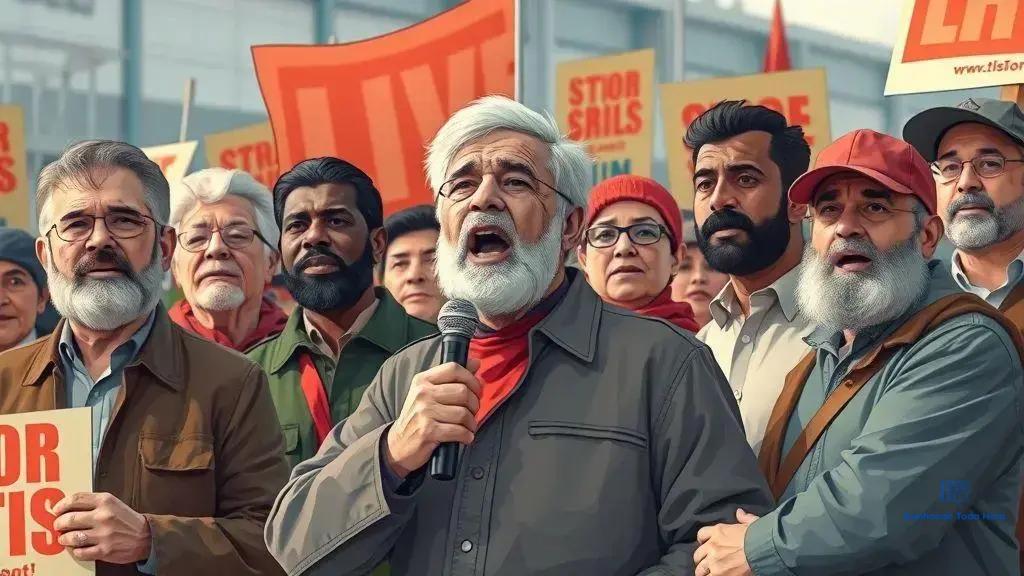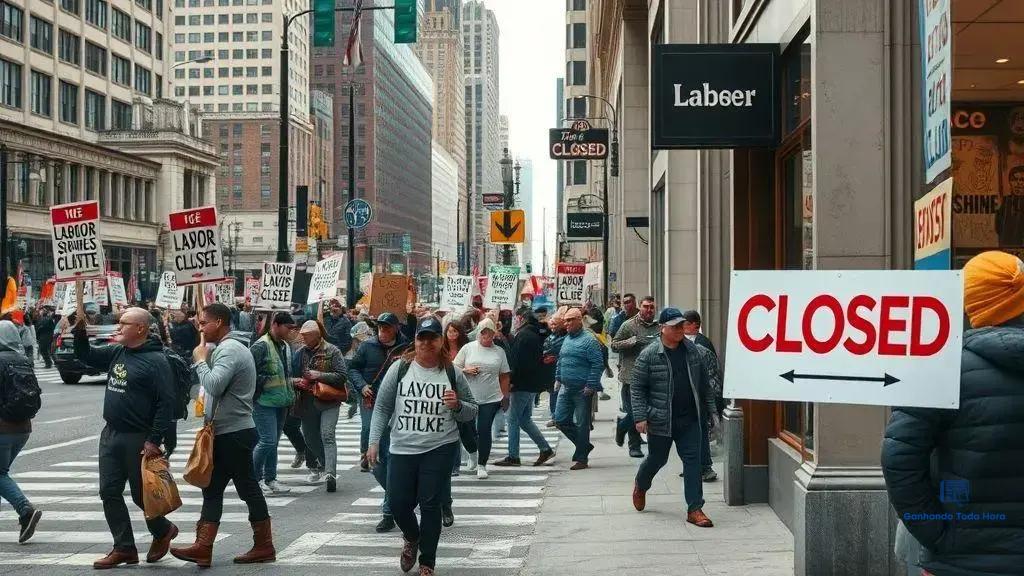Labor union strikes: what you need to know

Anúncios
Labor union strikes are organized actions by workers to demand better pay and working conditions, significantly impacting workers’ rights and influencing economic policies.
Labor union strikes have long been a pivotal part of workers’ rights movements. They not only spotlight grievances but also shape labor policies. Have you ever wondered what drives these powerful actions?
Anúncios
Understanding labor union strikes
Understanding labor union strikes is essential for grasping their significance in the labor movement. These strikes arise when workers, represented by unions, decide to halt work to demand better conditions or pay.
Strikes can vary widely in their causes and implications. They are not just about pay; issues such as workplace safety, benefits, and working hours are often at stake.
Key Reasons for Labor Union Strikes
The motivations behind these strikes can be complex. Workers often feel compelled to strike when negotiations fail.
- Wage disputes
- Poor working conditions
- Job security
- Lack of healthcare benefits
The impact of a strike can ripple through an entire industry. For instance, when key sectors, like manufacturing or education, halt operations, it can lead to significant economic effects.
Anúncios
Strikes and Worker Solidarity
Another important aspect of labor union strikes is the solidarity they foster among workers. Striking often brings workers together, reinforcing a sense of community and shared purpose.
This unity is crucial, as it empowers workers to stand firm against larger corporations. They believe that with collective action, they can achieve their goals more effectively.
Strikes also highlight a very public display of grievances. This public awareness can pressure companies to negotiate and address workers’ demands. When communities recognize the struggles of striking workers, there can be a shift in public support.
Recent Examples of Strikes
In recent years, there have been several notable labor union strikes that brought issues to light.
- The teachers’ strike in 2020 emphasized education funding.
- A major automotive workers’ strike illustrated issues of fair wages.
- Healthcare workers often strike for safe working conditions during crises.
- Service workers have raised concerns about unfair labor practices.
These strikes not only influence specific industries but also have broader implications for policy changes and labor laws. They reveal the ongoing struggle for workers’ rights and the importance of unions in advocating for those rights.
The role of labor unions in strikes

The role of labor unions in strikes is fundamental to understanding how workers organize for their rights. Unions serve as the voice for employees, ensuring that their grievances are heard and addressed.
When workers feel their needs are not being met, unions mobilize to negotiate better terms. This collective action not only empowers individual workers but also strengthens their bargaining power through unity.
Functions of Labor Unions During Strikes
Labor unions play several key roles when a strike is called. They help to coordinate the strike and communicate its purpose to both members and the public.
- Negotiating with employers on behalf of workers.
- Providing legal support and guidance during the strike.
- Offering financial assistance to striking workers.
- Engaging in public relations to garner support.
These functions highlight the union’s purpose in not just advocating for pay increases but also ensuring safe working conditions and fair treatment.
The Impact of Union Leadership on Strikes
Union leaders are crucial during a strike. Their leadership styles can influence its success or failure. Strong leaders keep members motivated and informed.
Moreover, they strategize the best approach to negotiations. When unions present a united front, it sends a powerful message to employers. This solidarity is vital for achieving favorable outcomes.
Additionally, unions often educate members about their rights and the importance of solidarity. This education fosters a more informed workforce, ready to stand up for their rights during negotiations and strikes.
Challenges Faced by Unions
While unions are instrumental, they also face challenges during strikes. For instance, they must maintain the support of their members throughout the strike. If workers become discouraged, the chances of a successful negotiation decrease.
- Resistance from employers.
- Media portrayal of strikes.
- Legal obstacles in organizing.
- Public opinion that may not favor the strike.
Each of these challenges can impact the effectiveness of the strike and the union’s ability to rally support.
Impact of strikes on workers’ rights
The impact of strikes on workers’ rights is profound and far-reaching. When workers strike, they draw attention to their demands and grievances. This action often leads to significant changes in labor policies and practices.
Strikes have historically contributed to advancements in workers’ rights. They set precedents for improved labor conditions and fair treatment. For example, major strikes in history have resulted in important legislation, such as minimum wage laws and workplace safety regulations.
Direct Effects of Strikes
When a strike occurs, it raises public awareness of the issues faced by workers. This awareness can lead to greater support from the community and potential allies. Strikes often result in:
- Negotiated raises in wages.
- Improved workplace safety standards.
- Enhanced benefits like healthcare and retirement plans.
- Stronger protections against unfair treatment.
This visibility can pressure employers to address these issues more promptly. Strikes not only impact the workers involved but also influence labor relations on a broader scale.
Long-Term Changes Brought by Strikes
The long-term consequences of strikes can reshape industries. Unions use the leverage gained from successful strikes to negotiate better contracts and workplace policies. Over time, these changes contribute to lasting improvements in labor rights.
Moreover, when unions successfully advocate for rights, they often inspire others in different sectors to organize and demand their rights. This ripple effect expands the reach of workers’ rights movements across industries.
Challenges to Workers’ Rights Post-Strikes
Despite their positive impacts, strikes can also lead to backlash from employers. In some cases, companies may retaliate against striking workers, which can discourage future organizing. The legal landscape surrounding strikes and labor actions can create challenges, making it essential for employees to understand their rights.
- Employers may implement stricter policies following a strike.
- Employees might face intimidation or job loss.
- Strikes can lead to a temporary loss of income for workers.
- Workplace divisions may occur if some employees do not support the strike.
In the end, while strikes can significantly advance workers’ rights, they also come with risks that need careful consideration.
How strikes affect the economy

Strikes have a significant impact on the economy, influencing both local and national financial circumstances. When workers decide to strike, they temporarily halt production, which can lead to immediate economic consequences.
The effects of strikes are felt not only by the companies involved but also by consumers and the broader market. For example, when a major industry like transportation is affected, supply chains and availability of goods can suffer greatly.
Immediate Economic Impacts
During a strike, businesses may experience loss of revenue due to halted operations. This can lead to:
- Decreased sales for companies.
- Economic strain on suppliers and partners.
- Temporary layoffs or reduced hours for non-striking workers.
- Loss of consumer trust in companies unable to resolve disputes.
These immediate impacts can ripple through the economy, creating a cycle of negative consequences.
Long-Term Economic Effects
While some effects are instantaneous, others can linger long after a strike concludes. For instance, if a strike gains significant public attention, it can lead to:
- Increased consumer prices as companies pass on costs to customers.
- Changes in labor laws or regulations that reshape industry standards.
- Long-term shifts in employment patterns or labor market dynamics.
These changes can affect the overall economic landscape, influencing everything from wages to job security across various sectors.
Strikes and Productivity
Strikes can also challenge productivity on a broader economic scale. When workers are dissatisfied and strike to demand better conditions, it highlights underlying issues within industries. This can prompt companies to rethink operational practices.
Improving working conditions often leads to increased employee morale and productivity when operations resume. Thus, while strikes may disrupt short-term productivity, they can lead to better workforce stability over time.
In conclusion, the effects of strikes on the economy are complex, involving both immediate and long-term implications that can influence various aspects of the labor market and consumer behavior.
Recent examples of notable labor strikes
Recent examples of notable labor strikes highlight the ongoing struggle for workers’ rights and better working conditions. These strikes have not only drawn attention to specific issues but have also rallied public support for labor movements.
One significant strike occurred in 2021 when teachers in several states walked out to demand better pay and funding for education. This action emphasized the need for fair compensation and improved resources in schools.
High-Profile Strikes
Another example is the strike by workers at a major automotive company last year. Employees protested against wage cuts and long working hours, bringing visibility to labor rights within the manufacturing sector.
- The strike lasted for several weeks and caused production delays.
- Public demonstrations garnered significant media attention.
- Negotiations eventually led to an agreement that included raises for workers.
- This action set a precedent for other manufacturing workers to follow.
Another remarkable instance was the healthcare workers’ strike during the pandemic. Workers protested for better safety measures and adequate staffing levels to handle the COVID-19 crisis. Their voices brought attention to the challenges faced in healthcare.
Impact of Recent Strikes
These recent strikes have had a lasting impact on policy and public opinion about workers’ rights. The visibility from media coverage often forces companies and governments to address workplace issues more directly.
As public support grows, unions feel empowered to take bold action. The combination of social media and traditional media has amplified the voices of strikers, making their messages resonate widely.
With each striking event, movements grow stronger, and the push for a fairer workplace continues to gain momentum across various industries.
FAQ – Frequently Asked Questions about Labor Union Strikes
What are labor union strikes?
Labor union strikes are organized demonstrations by workers to protest against their employers for better pay, working conditions, or other labor rights.
How do strikes impact workers’ rights?
Strikes can lead to significant improvements in workers’ rights by highlighting issues, promoting public awareness, and pushing for negotiations that benefit employees.
What are some recent examples of notable strikes?
Recent notable strikes include teachers demanding better funding, automotive workers protesting wage cuts, and healthcare workers advocating for improved safety during the pandemic.
How do strikes affect the economy?
Strikes can disrupt local economies by halting production and affecting supply chains, but they can also lead to long-term policy changes that improve labor conditions.